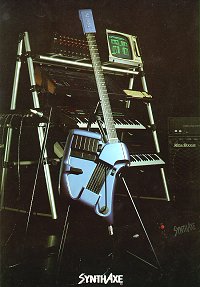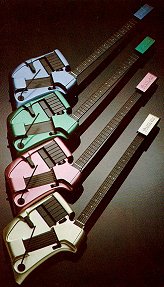SynthAxe
"This ain't no MIDI guitar."
Sadly the SynthAxe is no longer available but here's what you're missing.
The SynthAxe was invented by Bill Aitken. It consists of a guitar like MIDI controller with the addition of right hand keys, a control console and a pedalboard which also houses the power supply. Complete with stands this takes 4 flight cases. The optional Step-On pedals add yet another. It's about as portable as a drum kit isn't.
Among the first players, Al Di Meola had one, Allan Holdsworth had two. I heard about the SynthAxe in January 1986 and, after a visit to the factory to check one out, took delivery of serial No.0006 in March.
How does it work?
Forget about MIDI guitars, this is a different instrument. MIDI guitars work by trying to convert the sound of the vibrating strings into MIDI data. It's very hard to do well and is always subject to delays. (The processor has to measure at least a whole cycle of audio.)The SynthAxe strings are sensors. The fretboard uses a clever diagonal cut to separate each fret into six zones. The string/fret matrix is scanned by a microprocessor and combined with information from string bend sensors to determine the pitch of the note. The string bend sensors work by passing a current through each string and measuring the change of electromagnetic field using tiny, (and very delicate) coils.
What do all those buttons do?

What is it like to play?
As you lift it from the stand the first thing you notice is the sheer weight of the thing. Inside that shiny fibreglass cover is a cast metal chassis and the neck appears to be made of steel. The weight of the neck tends to pull downward but removing the headstock cover improves this a little. It is far more comfortable to play sitting down.The neck feels a little strange at first, the fret spacing is non-standard and the frets feel high. As the thickness and tension of the strings have no affect on pitch the SynthAxe is normally strung with 0.13 gauge strings all the way across giving a very light action. When you hit a note the response is instant. Bends, hammers, pull-offs, trills - no problem.
You can use the right hand trigger strings to play it like a guitar but for me the trigger keys are far better. Obviously they are velocity sensitive but they also offer polyphonic aftertouch. Imagine holding a chord and being able to vary the tone of each note individually. Once you have triggered a note you can let go of the fretted string and the note will hold until the key is released.
The SynthAxe exposes shortcomings in many manufacturers MIDI implementations. In mono mode a legato (without a re-trigger) pitch update is initiated by sending the new note-on before the note-off. This works perfectly on Yamaha and Oberheim instruments but Roland have their own special interpretation of the MIDI specification. You can crash sequencers with it too! Six channels of pitch bend and aftertouch will see off most of them.
FAQ
Q: How much do they cost?A: Back in 1986 a complete system was nearly £10,000 sterling.
Q: Where can I buy one?
A: I've heard this question rather a lot since this page was posted, so:
- I really don't know.
- They must be pretty rare as so few were made in the first place.
- One recently changed hands for $5000.
A: The "classic" SynthAxe joke is to invert the pitch bend law. It's actually quite useful. No, really.
![]()
Please send comments to: john@hollis.co.uk
Copyright ©1997 John Hollis. All Rights Reserved. This material may not be reproduced in any form without the prior written consent of the author. Trademarks are acknowledged where used.

